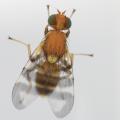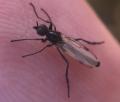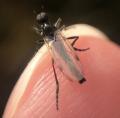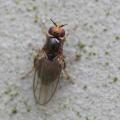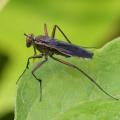Diptera.info :: Identification queries :: Diptera (adults)
Who is here? 1 guest(s)
|
Calliphora uralensis?
|
|
| crex |
Posted on 20-08-2007 22:15
|
|
Member Location: Sweden Posts: 1996 Joined: 22.05.06 |
Location: About 80 km NW of Stockholm, Sweden Date: 2007-08-18 Habitat: Pear on the ground in garden. I don't know if there are blue Neomyia cornicina as there are blue and green Neomyia viridescens. If there are, this might be a male Neomyia cornicina or ... something completely different  Neomyia seems to have a very sharp vein bend for a Muscidae species. Neomyia seems to have a very sharp vein bend for a Muscidae species.Edit: Changed subject (Neomyia sp?) Edit: Changed subject (Calliphoridae) crex attached the following image:  [133.12Kb] Edited by crex on 24-08-2007 08:45 |
|
|
|
| crex |
Posted on 20-08-2007 22:15
|
|
Member Location: Sweden Posts: 1996 Joined: 22.05.06 |
Another view.
crex attached the following image:  [137.14Kb] |
|
|
|
| Nikita Vikhrev |
Posted on 20-08-2007 22:19
|
|
Member Location: Moscow, Russia Posts: 9228 Joined: 24.05.05 |
No, Calliphorida Nikita Nikita Vikhrev - Zool Museum of Moscow University |
|
|
|
| crex |
Posted on 20-08-2007 22:19
|
|
Member Location: Sweden Posts: 1996 Joined: 22.05.06 |
Ahh, ok, thank you Nikita!  |
|
|
|
| Susan R Walter |
Posted on 21-08-2007 13:20
|
|
Member Location: Touraine du Sud, central France Posts: 1802 Joined: 14.01.06 |
I think Calliphora uralensis - no distinct vittae, lower calypter darkened to rim.
Susan |
| crex |
Posted on 24-08-2007 08:44
|
|
Member Location: Sweden Posts: 1996 Joined: 22.05.06 |
Thank you very much Susan. You are our Calliphoridae expert. Is the ID safe enough for the gallery? |
|
|
|
| Susan R Walter |
Posted on 24-08-2007 09:05
|
|
Member Location: Touraine du Sud, central France Posts: 1802 Joined: 14.01.06 |
Crex you are making me nervous - I am still just learning Calliphoridae. It is clearly not C vicina, and I think that is useful. But it has some reddish hairs on the beard and behind the head, but it does not seem to have mostly red hair - C uralensis does sometimes have some red hairs, just as C vomitoria can have some black. Without a full lateral view and maybe a front on view (to see facial dusting) in perfect lighting I don't feel I can state categorically it is not C vomitoria. How about putting it in the gallery as Calliphora cf uralensis and see if we are challenged 
Susan |
| crex |
Posted on 24-08-2007 09:28
|
|
Member Location: Sweden Posts: 1996 Joined: 22.05.06 |
Thanks again Susan. I didn't intend to scare you  Unfortunately I don't have full front or side views Unfortunately I don't have full front or side views  I guess Calliphora uralensis is a smaller species than C. vicina and C. vomitoria because my fly seems not to be so heavy (sturdy) as the other two. Also it doesn't have the big chin the other two have. It feels more like a Muscidae to me, but I only look at the pictures. I don't know the bristles and veins as you do. |
|
|
|
| Susan R Walter |
Posted on 24-08-2007 12:48
|
|
Member Location: Touraine du Sud, central France Posts: 1802 Joined: 14.01.06 |
They are all much the same size, but they can also all vary enormously in size. Females will lay eggs on a carcass for many days, until there isn't a single morsel of meat left on it. This means that the eggs laid on day 1 hatch into maggots that get to eat as much as they can stuff in, and then emerge as big fat adults. Eggs that are laid days later will not hatch to the same abundant food supply and as a consequence the resultant flies will be less well nourished and smaller or stunted. Those unlucky enough to be from eggs laid right at the end of the process probably actually run out of food and die before pupating. Good easy to spot clues to this fly being Calliphora sp are the combination of very sharply bending M vein, metallic blue body and the darkened lower calypter (aka squamae). Susan |
| crex |
Posted on 24-08-2007 14:04
|
|
Member Location: Sweden Posts: 1996 Joined: 22.05.06 |
Ok, a Calliphora it is. A pity I didn't take more photos of it ... it seems you can never take enough shots  Fauna Europaea states these are found in Sweden: - Calliphora genarum (Zetterstedt 1838) - Calliphora loewi Enderlein 1903 - Calliphora stelviana (Brauer & Bergenstamm 1891) - Calliphora subalpina (Ringdahl 1931) - Calliphora uralensis Villeneuve 1922 - Calliphora vicina Robineau-Desvoidy 1830 - Calliphora vomitoria (Linnaeus 1758) I wonder what literature one should use to learn more about Calliphora ... |
|
|
|
| Zeegers |
Posted on 24-08-2007 14:42
|
|
Member Location: Soest, NL Posts: 18539 Joined: 21.07.04 |
Rognes, Fauna Scandinavica Blowflies. Terrific book, works even in Siberia !! Theo |
|
|
|
| Susan R Walter |
Posted on 24-08-2007 22:25
|
|
Member Location: Touraine du Sud, central France Posts: 1802 Joined: 14.01.06 |
...and then again, it might be Bellardia - I've just noticed it looks like it has an appendix on Cu. Crex has a point about the 'chin' too. Maybe those red hairs are an artefact. A single strong pv on T1 and looks like might have distinct discal bristles on tergite 4 leads to B viarum, but who knows really... I give up 
Susan |
| crex |
Posted on 24-08-2007 22:49
|
|
Member Location: Sweden Posts: 1996 Joined: 22.05.06 |
Thanks for trying Susan. I appreciate it. Here is a better view of the veins.
crex attached the following image:  [121.33Kb] |
|
|
|
| Nikita Vikhrev |
Posted on 24-08-2007 22:51
|
|
Member Location: Moscow, Russia Posts: 9228 Joined: 24.05.05 |
Rognes, Fauna Scandinavica Blowflies. I've just got this book  But I'm not ready to answer yet (give my a year  ) )But Bellardia has blackish thorax and greenish abdomen, doesn't it? But Melinda is bluish as this fly, not? Nikita Nikita Vikhrev - Zool Museum of Moscow University |
|
|
|
| Susan R Walter |
Posted on 24-08-2007 23:37
|
|
Member Location: Touraine du Sud, central France Posts: 1802 Joined: 14.01.06 |
Well, I think this distinction is rather a rule of thumb. I think Bellardia can have thorax and abdomen both metallic, either blue or green. I know all the texts use the blue for Melinda and green for Bellardia distinction, but it seems to me that sometimes it is easier to ignore that character because it can cause a dead end with the key. I think these colours are difficult because what one person will call green another will call blue, and being metallic only compounds the problem. Anyway, now you've got Rognes you'll be the new Calliphorid star in no time. I won't have to spend all my time scratching my head - I'll just ask you 
Susan |
| Jump to Forum: |




